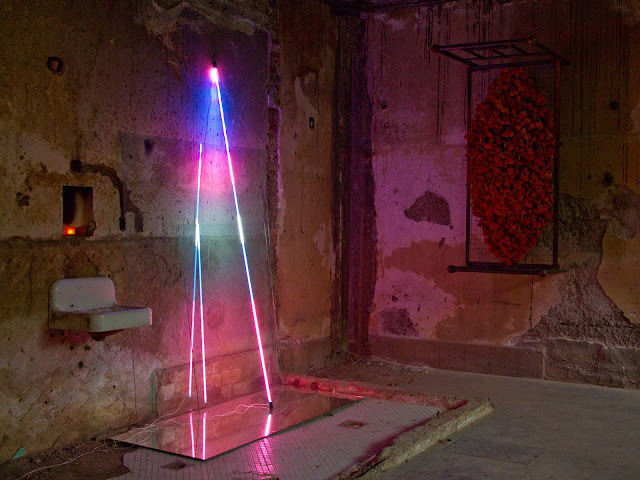


In Oaxaca in December, before one can arrive at La Noche
Buena, Christmas Eve you must traverse many other festivals. On December 8th there is la
fiesta de La Virgen de Juquila, the Feast of the Virgin of Juquila. On December 12th there is la
fiesta de La Virgen de Guadalupe, the Feast of the Virgin of Guadalupe,
celebrated throughout Mexico.
Starting on December 16th are the first of nine traditional
Posadas, one each night, including Christmas Eve. On December 18th there is la fiesta de La Virgen
de la Soledad, the Feast of the Virgin of Solitude, the patron saint of
Oaxaca. On December 23rd
there is the La Noche de los Rábanos, or Night of the Radishes. Then finally on
December 24th we come to La Noche Buena, Christmas Eve. Afterwards there is New Years Eve; then
on the first Sunday in January, the Paradita del Niño Dios; on January 6th,
the feast of the Three Kings; and finally on Februray 2nd the
Christmas season ends with La Candelaria or purification of the Virgin and the
blessing of the infant Jesus. But this post is about Nuestra Señora de
Guadalupe.

Nuestra Señora de Guadalupe, also known as the Virgen de
Guadalupe is a celebrated Roman Catholic icon of the Virgin Mary and revered as
the patron saint and Queen of all México. In Oaxaca there are many activities
associated with this day, some religious such as the calendas or religious
processions, as well as music, fireworks and the carnival rides.


Now for a bit of history mixed with folklore. Two accounts, published in the 1640s,
one in Spanish, one in Nahuatl, tell how, while walking from his village to
Mexico City in the early morning of December 9, 1531 on the Feast of the
Immaculate Conception, the peasant Juan Diego saw on the slopes of the hill of
Tepeyac a vision of a girl of fifteen or sixteen years of age, surrounded by
light. Speaking to him in Nahuatl, the local language, she asked that a church
be built at that site, in her honor.
Juan Diego recognized her as the Virgin Mary. Diego told his story to
the Spanish Archbishop, Fray Juan de Zumárraga, who instructed him to return to
Tepeyac, and ask the lady for a miraculous sign to prove her identity. The
first sign was the healing of Juan's uncle. The Virgin told Juan Diego to
gather flowers from the top of the hill of Tepeyac. Although it was December,
Juan Diego found Castilian roses, not native to Mexico, at the usually barren
hilltop. The Virgin arranged them in his peasant cloak. When Juan Diego opened
the cloak before Bishop Zumárraga on December 12, the flowers fell to the
floor, and in their place was the image of the Virgin of Guadalupe,
miraculously imprinted on the fabric. The Basílica de Nuestra Señora de
Guadalupe was built near the location where the Virgen appeared to Juan Diego. Construction of the old basilica began in 1531
and was not finished until 1709.
The devotion to la Nuestra Señora de Guadalupe grew to be so important
that in 1754 a papal bull was issued proclaiming the Virgin of Guadalupe as the
Patroness and Protector of New Spain. In 1810 she was adopted as the symbol of
Mexican Independence and in 1904 Pope Pius X elevated the church built on the
site to the category of basilica.


From Patricia Harrington, "The Aztecs ... had an elaborate, coherent symbolic system for making sense of their lives. When this was destroyed by the Spaniards, something new was needed to fill the void and make sense of New Spain ... the image of Guadalupe served that purpose."
The Conquistador, Hernán Cortés, was a native of Extremadura, in Spain, home to Our Lady of Guadalupe. By the 16th century the Extremadura Guadalupe, a statue of the Virgin was already a national icon. It was found at the beginning of the 14th century when the Virgin appeared to a humble shepherd and ordered him to dig at the site of the apparition. The recovered Virgin then miraculously helped to expel the Moors from Spain, and her small shrine evolved into the great Guadalupe monastery. One of the more remarkable attributes of the Guadalupe of Extremadura is that she is dark, like the Americans, and thus she became the perfect icon for the missionaries who followed Cortés to convert the natives to Christianity. According to secular history, in 1555 Bishop Alonso de Montúfar commissioned a Virgin of Guadalupe from a native artist, who gave her the dark skin which his own people shared with the famous Extremadura Virgin. Whatever the connection between the Mexican and her older Spanish namesake, the fused iconography of the Virgin and the indigenous Nahua goddess Tonantzin provided a way for 16th-century Spaniards to gain converts among the indigenous population, while simultaneously allowing 16th century Mexicans to continue the practice of their native religion.


Guadalupe continues to symbolize a mixture of the cultures
which blended to form Mexico, both racially and religiously, "the first
mestiza", or "the first Mexican". As the Christians built their first churches with the rubble
and the columns of the ancient pagan temples, so they often borrowed pagan
customs for their own cult purposes. Guadalupe is a "common
denominator" uniting Mexicans who are composed of a vast patchwork of
differences – linguistic, ethnic, and class-based. The Virgin of Guadalupe is the bond that binds this
disparate nation into a whole. In 1974 Nobel Literature laureate Octavio Paz
wrote, "the Mexican people, after more than two centuries of experiments,
have faith only in the Virgin of Guadalupe and the National Lottery".
All of the area around the Llano Park in front of the Iglesia de Guadalupe is filled with carnival rides, puestos selling all sorts of things especially food, and special attractions for children. The following is a montage of the rides in Llano Park. Please visit my Picasa Web Album for more photos.



















































